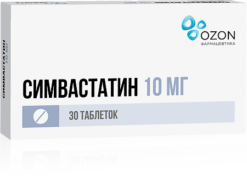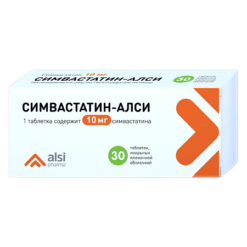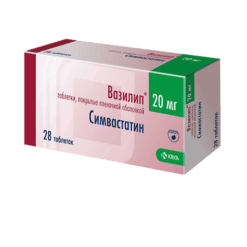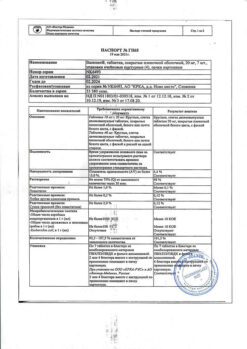No products in the cart.
Sanofi Simvastatin, 10 mg 28 pcs
€1.00
Out of stock
(E-mail when Stock is available)
Description
Hypolipidemic drug produced synthetically from the fermentation product of Aspergillus terreus.
Pharmacodynamics:
. After oral administration simvastatin, which is an inactive lactone, undergoes hydrolysis in the liver to form the corresponding form β-hydroxy acid simvastatin, which is the main metabolite and has high inhibitory activity against HMG-CoA (3-hydroxy-3-methylglutaryl coenzyme A) reductase, the enzyme that catalyzes the initial and most important stage of cholesterol biosynthesis.
Clinical studies have shown the effectiveness of simvastatin in reducing plasma concentrations of total cholesterol (TC), low-density lipoprotein cholesterol (LDL-C), triglycerides (TG) and very low-density lipoprotein cholesterol (VLDL-C), as well as elevated high-density lipoprotein cholesterol (HDL-C) in patients with heterozygous familial and nonfamilial hypercholesterolemia or mixed hyperlipidemia when elevated cholesterol is a risk factor and dietary intervention alone is not sufficient.
Significant therapeutic effect is observed within 2 weeks of taking the drug, the maximum therapeutic effect – within 4-6 weeks after the start of treatment. The effect persists with the continuation of therapy. When discontinuation of simvastatin therapy cholesterol concentration returns to the initial value observed before the start of treatment.
The active metabolite of simvastatin is a specific inhibitor of HMG-CoA reductase, the enzyme that catalyzes the reaction of mevalonate formation from HMG-CoA. Despite this, simvastatin administration in therapeutic doses does not lead to complete inhibition of HMG-CoA reductase, which allows to maintain the production of biologically necessary amount of mevalonate. Since the early stage of cholesterol biosynthesis is conversion of HMG-CoA to mevalonate, it is believed that simvastatin administration should not cause accumulation of potentially toxic sterols in the body. In addition, HMG-CoA is rapidly metabolized back to acetyl-CoA, which is involved in many biosynthesis processes in the body.
While cholesterol is a precursor of all steroid hormones, no clinical effect of simvastatin on steroidogenesis has been observed.
Because simvastatin did not cause an increase in bile lithogenicity, its effect on increasing the incidence of cholelithiasis is unlikely.
Simvastatin reduces both elevated and normal LDL cholesterol concentrations. LDL is formed from very low density lipoproteins (VLDL). LDL catabolism is predominantly performed by the high-affinity LDL receptor. The mechanism of decrease of LDL cholesterol concentration after simvastatin administration may be due to both decrease of LDL cholesterol concentration and activation of LDL receptor, which leads to decreased formation and increased catabolism of LDL cholesterol.
Simvastatin therapy also significantly reduces the concentration of apolipoprotein B (apo B). Since each LDL particle contains one molecule of apo B, and small amounts of apo B are found in other lipoproteins, it can be assumed that simvastatin not only causes loss of cholesterol in LDL particles, but also reduces the concentration of circulating LDL particles.
Indications
Indications
Patients with coronary heart disease or high risk of CHD
Patients at high risk of CHD (with or without hyperlipidemia). In patients at high risk of CHD (with or without hyperlipidemia), such as patients with diabetes mellitus, patients with a history of stroke or other cerebrovascular disease, patients with peripheral vascular disease or patients with CHD or predisposition to CHD, Simvastatin is indicated for:
– Reducing the risk of overall mortality by reducing mortality due to CHD.
– Reducing the risk of serious vascular and coronary complications:
– Reducing the risk of the need for surgical interventions to restore coronary blood flow (such as aortocoronary bypass and percutaneous transluminal coronary angioplasty).
– Reducing the risk of the need for peripheral blood flow repair surgery and other types of noncoronary revascularization.
– Reducing the risk of hospitalization for angina attacks.
Hyperlipidemia
. – As an adjunct to diet, when the use of diet alone and other non-drug therapies in patients with primary hypercholesterolemia, including heterozygous familial hypercholesterolemia (Fredrickson Classification Type IIa hyperlipidemia), or mixed hypercholesterolemia (Fredrickson Classification Type IIb hyperlipidemia) is not sufficient for:
– Hypertriglyceridemia (hyperlipidemia type IV according to Fredrickson classification).
– Complement to diet and other treatments for patients with homozygous familial hypercholesterolemia to reduce elevated concentrations of CHC, LDL cholesterol and apo B.
– Primary dysbetalipoproteinemia (Fredrickson classification type III hyperlipidemia).
The use in children with heterozygous seminal hypercholesterolemia
. The use of Simvastatin concomitantly with diet is indicated to reduce elevated concentrations of CHC, LDL cholesterol, TG, apo B in young males 10-17 years old and in girls 10-17 years old at least 1 year after menarche (first menstrual bleeding) with heterozygous familial hypercholesterolemia.
Active ingredient
Active ingredient
Composition
Composition
One film-coated tablet contains:
the active ingredient:
simvastatin – 10 mg;
microcrystalline cellulose – 70.00 mg,
How to take, the dosage
How to take, the dosage
Overly, once a day, in the evening, with plenty of water. The time of taking the drug should not be associated with food intake.
Before starting treatment with Simvastatin, the patient should be prescribed a standard hypocholesterolemic diet, which should be followed during the entire course of treatment.
The recommended dose of Simvastatin for treatment of hypercholesterolemia varies from 10 to 80 mg once daily in the evening. The recommended starting dose of the drug for patients with hypercholesterolemia is 10 mg. The maximum daily dose is 80 mg.
Changing (adjusting) the dose should be done at 4 week intervals. In most patients the optimal effect is achieved with doses up to 20 mg/day.
In patients with homozygous hereditary hypercholesterolemia the recommended daily dose of Simvastatin is 40 mg once daily in the evening or 80 mg in 3 doses (20 mg in the morning, 20 mg during the day and 40 mg in the evening).
When treating patients with CHD or high risk of CHD, effective doses of Simvastatin are 20-40 mg/day. Therefore, the recommended starting dose in such patients is 20 mg/day. The dose should be changed (adjusted) at 4 week intervals; if necessary, the dose can be increased to 40 mg/day. In elderly patients and patients with mild to moderately expressed renal insufficiency, there is no need to change the dosage of the drug.
In patients with CKD (creatinine Cl
In patients taking amiodarone or verapamil concomitantly with Simvastatin, the daily dose should not exceed 20 mg.
Interaction
Interaction
Cytostatics, antifungal agents (ketoconazole, itraconazole), fibrates, high-dose nicotinic acid, immunosuppressants, erythromycin, clarithromycin, telithromycin, HIV protease inhibitors, nefazodone increase the risk of myopathy.
Cyclosporine or danazole: the risk of myopathy/rhabdomyolysis is increased when cyclosporine or danazole are coadministered with high-dose simvastatin.
Other hypolipidemic agents that may cause myopathy: the risk of myopathy is increased by co-administration of other hypolipidemic agents that are not potent CYP3A4 inhibitors but that may cause myopathy with monotherapy. Such as gemfibrozil and other fibrates (except fenofibrate), as well as niacin (nicotinic acid) at a dose of > 1 g/day.
Amiodarone and verapamil: the risk of myopathy increases when coadministering amiodarone or verapamil with high doses of simvastatin.
Diltiazem: the risk of myopathy increases slightly in patients receiving diltiazem concomitantly with simvastatin at a dose of 80 mg.
Simvastatin potentiates the effect of peroral anticoagulants (e.g., phenprocoumon, warfarin) and increases the risk of bleeding, which requires monitoring of blood clotting prior to treatment, and often enough during the initial period of therapy. Once a stable level of prothrombin time or International Normalized Ratio (MHO) is achieved, it should be further monitored at intervals recommended for patients receiving anticoagulant therapy. Prothrombin time or MHO should also be monitored according to the above scheme if the dosage is changed or simvastatin is discontinued.
Therapy with simvastatin does not cause changes in prothrombin time and risk of bleeding in patients not taking anticoagulants. Increases plasma levels of digoxin.
Colestyramine and colestipol reduce bioavailability (use of simvastatin is possible 4 hours after taking these drugs, with an additive effect).
Grapefruit juice contains one or more components that inhibit CYP3A4 and may increase the plasma concentration of drugs metabolized by CYP3A4. The increase in HMG-CoA reductase inhibitor activity after consuming 250 ml of juice per day is minimal and of no clinical significance. However, consumption of a large volume of juice (more than 1 liter per day) while taking simvastatin significantly increases the level of inhibitory activity against HMG-CoA reductase in plasma. In this regard, consumption of grapefruit juice in large quantities should be avoided.
Special Instructions
Special Instructions
In the beginning of therapy with simvastatin, there may be a transient increase in liver enzymes.
Liver function tests should be performed regularly before initiating therapy and thereafter (monitor liver enzyme activity every 6 weeks for the first 3 months, then every 8 weeks for the remaining first year, and then once every six months), and a liver function test should be performed if doses are increased. If the dose is increased to 80 mg, a test should be performed every 3 months. If there is a persistent increase in transaminase activity (3 times the baseline level), simvastatin should be discontinued.
Simvastatin, like other HMG-CoA reductase inhibitors, should not be used if there is an increased risk of rhabdomyolysis and renal failure (against the background of severe acute infection, arterial hypotension, planned major surgery, trauma, severe metabolic disorders).
The withdrawal of hypolipidemic agents during pregnancy has no significant effect on the results of long-term treatment of primary hypercholesterolemia.
Due to the fact that HMG-CoA reductase inhibitors inhibit cholesterol synthesis, and cholesterol and other products of its synthesis play an essential role in fetal development, including steroid and cell membrane synthesis, simvastatin may have adverse effects on the fetus when prescribed to pregnant women (women of reproductive age should avoid conception). If pregnancy occurs during treatment, the drug should be withdrawn and the woman should be warned about the possible danger to the fetus.
The use of simvastatin is not recommended in women of childbearing age who do not use contraception.
In patients with reduced thyroid function (hypothyroidism) or in the presence of certain kidney diseases (nephrotic syndrome) when cholesterol levels increase, therapy of the underlying disease should be given first.
Simvastatin is prescribed with caution in people who abuse alcohol and/or have a history of liver disease.
The patient should be on a hypocholesterolemic diet before and during treatment.
The concomitant administration of grapefruit juice may increase the severity of side effects associated with taking simvastatin, so concomitant administration should be avoided.
Simvastatin is not indicated in cases with hypertriglyceridemia types I, IV and V.
The treatment with simvastatin may cause myopathy leading to rhabdomyolysis and renal failure. The risk of this pathology increases in patients receiving one or more of the following drugs concomitantly with simvastatin: fibrates (gemfibrozil, fenofibrate), cyclosporine, nefazadone, macrolides (erythromycin, clarithromycin), antifungal agents of azole group (ketoconazole, intraconazole) and HIV protease inhibitors (ritonavir). The risk of myopathy also increases in patients with severe renal insufficiency.
All patients starting therapy with simvastatin, as well as patients who need to increase the dose of the drug, should be warned about the possibility of myopathy and the need to seek immediate medical attention if unexplained pain, muscle soreness, sluggishness or muscle weakness occur, especially if accompanied by malaise or fever. Therapy with the drug should be stopped immediately if myopathy is diagnosed or suspected.
In order to diagnose the development of myopathy, regular measurements of CPK are recommended.
The treatment with simvastatin may increase serum CPK, which should be considered in the differential diagnosis of chest pain. The criterion for discontinuation of the drug is an increase in serum CPK more than 10 times the upper limit of normal. In patients with myalgia, myasthenia and/or marked increase of CPK activity, the drug shall be discontinued.
The drug is effective both as monotherapy and in combination with bile acid sequestrants.
If the current dose is missed, the drug should be taken as soon as possible.
If it is time to take the next dose, the dose should not be doubled.
Patients with severe renal insufficiency should have their renal function monitored.
The duration of use of the drug is determined by the attending physician individually.
Impact on driving and operating machinery
There have been no adverse effects of Simvastatin on driving and operating machinery.
Contraindications
Contraindications
Hypersensitivity to any component of the drug.
– Liver disease in the active phase or persistent increase in plasma “hepatic” transaminase activity of unknown etiology.
– Pregnancy or breastfeeding.
– Age before 18 years of age (except children 10-17 years of age with heterozygous familial hypercholesterolemia).
– Lactose intolerance, lactase deficiency or glucose-galactose malabsorption.
– Concomitant treatment with potent CYP3A4 isoenzyme inhibitors (itraconazole, ketoconazole, posaconazole, voriconazole, HIV protease inhibitors, boceprevir, telaprevir, erythromycin, clarithromycin, telithromycin, nefazodop and medicines containing cobicistat).
– Concomitant treatment with gemfibrozil, cyclosporine, or danazol.
– Concomitant use of simvastatin in doses greater than 40 mg with lomitapide in patients with familial homozygous hypercholesterolemia.
Severe renal insufficiency (creatinine clearance less than 30 ml/min); alcohol abuse prior to treatment; patients after organ transplantation who are receiving immunosuppressant therapy; history of liver disease; severe electrolyte-water balance disorders; arterial hypotension; severe acute infections (sepsis); marked endocrine and metabolic disorders, major surgical interventions, trauma; hereditary muscle diseases, myopathy against the background of taking statins in the history, reduced or increased skeletal muscle tone of unclear etiology, epilepsy; concomitant use with fibrates (except fenofibrate), nicotinic acid in lipid-lowering doses (more than 1 g/day), amiodarone, amlodipine, verapamil, diltiazem, ranolazine, dronedarone, grapefruit juice; diabetes; use in patients of Mongoloid race, old age (over 65 years, especially women).
Side effects
Side effects
Digestive system disorders: constipation, diarrhea, loss of appetite, flatulence, nausea, abdominal pain, pancreatitis, increased ALT, AST, GGT, ALP activity.
CNS and peripheral nervous system disorders: headache, dizziness, muscle cramps, paresthesias, peripheral neuropathy.
Cardiovascular system disorders: transient arterial hypotension is possible.
Muscular system disorders: myalgia, myopathy, rhabdomyolysis, increased CPK activity.
Allergic reactions: rarely – angioedema, lupus-like syndrome, vasculitis, thrombocytopenia, eosinophilia, increased sedimentation, arthritis, urticaria, fever, shortness of breath.
Dermatological reactions: photosensitization, skin rash, itching, skin hyperemia, alopecia.
Others: anemia.
Overdose
Overdose
None of the known few cases of overdose (maximum dose taken 450 mg) have shown specific symptoms.
Treatment: induce vomiting, take activated charcoal. Symptomatic therapy. Liver and renal functions and serum CPK levels should be monitored.
In case of myopathy with rhabdomyolysis and acute renal failure (a rare but severe side effect) the drug should be stopped immediately and the patient should be given a diuretic and sodium bicarbonate (intravenous infusion). Hemodialysis is indicated if necessary.
Rhabdomyolysis may cause hyperkalemia, which may be managed by intravenous calcium chloride or calcium gluconate administration, glucose and insulin infusion, use of potassium ion exchangers or, in severe cases, with hemodialysis.
Similarities
Similarities
Additional information
| Shelf life | 3 years. Do not use after the expiration date printed on the package. |
|---|---|
| Conditions of storage | At a temperature not exceeding 25 ° C, in the original package. Store out of the reach of children. |
| Manufacturer | Zentiva k.s., Czech Republic |
| Medication form | pills |
| Brand | Zentiva k.s. |
Other forms…
Related products
Buy Sanofi Simvastatin, 10 mg 28 pcs with delivery to USA, UK, Europe and over 120 other countries.

















